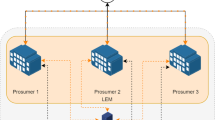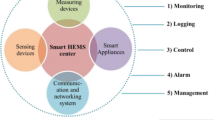Abstract
In this paper, planning, optimization and analysis of an Islanded microgridhas been presented for rural community of India. Daily load profile of rural community has been considered for configuring the various micro gridsusing generation from solar, wind and generator. Simulation is carried out using Homer grid software, developed by National Renewable Energy Laboratory,United State of America, to obtain optimal micro grid configuration having lowest cost and minimum emission of harmful gases. To simulate the realistic scenarios of micro grid, historical data pertaining to wind speed and solar irradiationof rural community of Gwalior, Madhya Pradesh, India have been obtained from National Aeronoutics and Space Agency. Simulation results of various micro grid configurations have been compared on the basis of cost per unit of electrical energy generation, and green house gases emission. To establish the superiority of proposed micro grid design, optimization results are also compared with existing work. Results reveals that the optimum combination of diesel generator, photo voltaic array, and battery is environment friendly as well as techno-economic for off grid rural community.













Similar content being viewed by others
References
Avilés AC, Oliva HS, WattsD, (2019) Single-dwelling and community renewable microgrids: Optimal sizing and energy management for new business models. Appl Energy 254:113665
Adefarati T, BansalR C (2019) Application of renewable energy resources in a microgrid power system. J Eng. 2019(18):5308–5313
Querikiol EM, TaboadaE B (2018) Performance Evaluation of a Micro Off-Grid Solar Energy Generator for Islandic Agricultural-Farm Operations Using HOMER. J Renew Energy 2018:1–9
Kumaraswamy VK, QuaicoeJ E (2017) Standalone fuel cell generation system with different tracking techniques: Economic analysis. IET Renew. Power Gener. 11(9):1186–1193
Habib HUR, Wang S, Elkadeem MR, Elmorshedy MF (2019) Design Optimization and Model Predictive Control of a Standalone Hybrid Renewable Energy System: A Case Study on a Small Residential Load in Pakistan. IEEE Access 7:1–1
Aziz N, Al Masood T, Deeba SR, Tushar W, Yuen C (2019) A methodology to prevent cascading contingencies using BESS in a renewable integrated microgrid. Int. J. Electr. Power Energy Syst. 110:737–746
DawoudS M, Lin X, Okba MI (2018) “Hybrid renewable microgrid optimization techniques: A review. Renew. Sustain. Energy Rev. 82(2017):2039–2052
Frate GF, Cherubini P, Tacconelli C, Micangeli A, Ferrari L, Desideri U (2019) Ramp rate abatement for wind power plants: A techno-economic analysis. Appl. Energy 254:113600
Hafez O, Bhattacharya K (2012) Optimal planning and design of a renewable energy-based supply system for microgrids. Renew. Energy 45:7–15
Hossain MA, Pota HR, Squartini S, Zaman F, Guerrero JM (2019) Energy scheduling of community microgrid with battery cost using particle swarm optimisation. Appl. Energy 254:113723
He L, Zhang S, Chen Y, Ren L, Li J (2018) Techno-economic potential of a renewable energy-based microgrid system for a sustainable large-scale residential community in Bei**g, China. Renew. Sustain. Energy Rev 93:631–641
Meena NK, Yang J, Zacharis E (2019) Optimisation framework for the design and operation of open-market urban and remote community microgrids. Appl. Energy 252:113399
Bahramara S, Moghaddam MP, Haghifam MR (2016) Optimal planning of hybrid renewable energy systems using HOMER : A review. Renew. Sustain. Energy Rev. 62:609–620
Wang R, Lam CM, Hsu SC, Chen JH (2019) Life cycle assessment and energy payback time of a standalone hybrid renewable energy commercial microgrid: A case study of Town Island in Hong Kong. Appl. Energy 250:760–775
Sawle Y, Gupta SC, Bohre AK (2018) “Review of hybrid renewable energy systems with comparative analysis of off-grid hybrid system. Renewable and Sustainable Energy Reviews, vol 81. UK, Elsevier Ltd, pp 2217–2235
Phurailatpam C, Rajpurohit BS, Wang L (2018) Planning and optimization of autonomous DC microgrids for rural and urban applications in India. Renew. Sustain. Energy Rev. 82(2017):194–204
C Phurailatpam, BS Rajpurohit, L Wang (2017) Optimization of DC microgrid for rural applications in India. IEEE Reg. 10 Annual. International. Conference. Proceedings/TENCON, pp. 3610–3613.
SK Chava, MS Kumar, V Rajeswari, SN Gowri (2022) Design of Hybrid Micro-grid under Islanding and Grid Connected Modes. 2022 International Conference on Sustainable Computing and Data Communication Systems (ICSCDS), Erode, India, pp. 839-845
Bhaskara SN, Chowdhury BH (2012) Micro grids — a review of modelling, control, protection, simulation and future potential. IEEE power & energy society general meeting, San Diego, CA, USA, pp 1–7
https://homerenergy.com
Hassan A, Saadawi M, Kandil M, Saeed M (2015) Modified particle swarm optimisation technique for optimal design of small renewable energy system supplying a specific load at Mansoura University. IET Renew Power Gene 9:474–83
Fossati JP, Galarza A, Martín-Villate A, Fontán L (2015) A method for optimal sizing energy storage systems for micro grids. Renew Energy 77:539–49
Hadidian-Moghaddam, Mohammad Jafar et al (2018) A multi-objective optimal sizing and siting of distributed generation using ant lion optimization technique. Ain Shams Eng J 9(4):2101–2109
Bahramirad S, Reder W, Khodaei A (2012) Reliability-constrained optimal sizing of energy storage system in a micro grid. IEEE Trans Smart Grid 3:2056–62
Chen SX, Gooi HB, Wang MQ (2012) Sizing of energy storage for micro grids. IEEE Trans Smart Grid 3:142–51
Fathima AH, Palanisamy K (2015) Optimization in micro grids with hybrid energy systems – A review. Renew Sustain Energy Rev 45:431–46
Shahinzadeh H, Moazzami M, Fathi SH, Gharehpetian GB (2017) “Optimal sizing and energy management of a grid-connected microgrid using HOMER software. 2016 Smart Grids Conf SGC 2016:13–18
Madhusudhan M, Kumar N, Pradeepa H (2021) Optimal location and capacity of DG systems indistribution network using genetic algorithm. Int J Inform Technol 13(1):155–162
Pathak D, Gaur P (2021) Output power control of wind energy system by tip speed ratio control using fractional PIβDα controller. Int J Inform Technol 13(1):299–305
Karunanithi K, Ramesh S, Raja SP, Sreedhar R, Kannan S, Ramudu V (2023) Investigationsof standalone PV system with battery-supercapacitor hybrid energy storage system for household applications. Int J Inform Technol 15(1):279–287
Nurhafizah MD (2022) A low-cost and convenient system-based real-time monitoring fors standalone power station. Int J Inform Technol 14(4):1703–1710
Patil MA, Parane K, Poojara S, Patil A (2021) Internet-of-things and mobile application basedhybrid model for controlling energy system”. Int J Inform Technol 13(5):2129–2138
Funding
The authors did not receive any external funding for conducting this research work.
Author information
Authors and Affiliations
Corresponding author
Ethics declarations
Conflict of interest
The authors declare no competing interests.
Additional information
Publisher’s Note
Springer Nature remains neutral with regard to jurisdictional claims in published maps and institutional affiliations.
Rights and permissions
Springer Nature or its licensor (e.g. a society or other partner) holds exclusive rights to this article under a publishing agreement with the author(s) or other rightsholder(s); author self-archiving of the accepted manuscript version of this article is solely governed by the terms of such publishing agreement and applicable law.
About this article
Cite this article
Jain, A.K., Barua, A. & Mishra, P.K. Optimal design and development of a microgrid for off-grid rural communities. Int. j. inf. tecnol. 16, 2229–2239 (2024). https://doi.org/10.1007/s41870-023-01708-7
Received:
Accepted:
Published:
Issue Date:
DOI: https://doi.org/10.1007/s41870-023-01708-7




